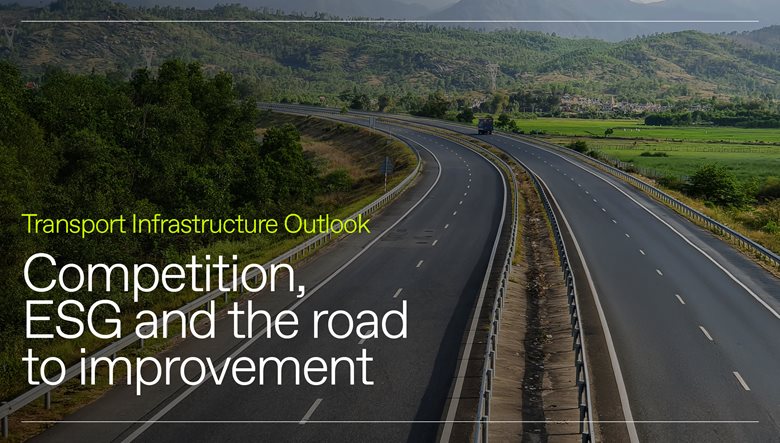Global transport infrastructure procurement 2025: Competition, ESG and the road to improvement
Sustainability is becoming an increasingly important priority in big transport initiatives.
By AnsaradaMon Jun 02 2025Mergers and acquisitions, Industry news and trends, Innovation

The transport infrastructure sector is balancing three conflicting priorities: the need for robust competition, growing sustainability mandates and a requirement for process efficiency. As nations ramp up investments in roads, railways, ports and smart mobility systems, procurement practices are under scrutiny to deliver value, equity and resilience.
Drawing on global survey data and industry insights from our 2025 Transport Infrastructure Outlook Report, developed in partnership with Infralogic, this blog unpacks the state of competition, ESG integration and critical improvements shaping procurement in 2025.
1. Regional divides and market concentration boost bidding competition
Competitive tension during bidding is a cornerstone of value-driven transport infrastructure procurement, but global disparities reveal uneven playing fields.
According to our report, while 66% of respondents rate competition as high or very high in their most recent projects, 5% report low competition, highlighting systemic gaps.
In Asia-Pacific, 72% of respondents say competition is high or very high, driven by booming infrastructure demand in India, Vietnam and Indonesia. In the Americas 66% of respondents say competition is high or very high, although one contractor dominance in complex projects such as US highway upgrades limits smaller firms. At 58%, EMEA is the region with the lowest competition, particularly in Europe, where entrenched contractors with technical expertise and financial muscle dominate.
While established contractors mitigate risks such as cost overruns and delays, their dominance stifles innovation. In the UAE, favoritism toward the same contractors deters new entrants, reducing competitive tension. In EMEA, mega-projects like the EU’s Trans-European Transport Network (TEN-T) often default to familiar players, sidelining smaller firms.
To address this, Audrey Bailly, Business Development Director in ANZ at Ansarada advocates breaking projects into smaller bundles.
“This allows a variety of contractors to participate, promoting innovation and improving efficiencies across multiple project stages. Smaller contractors can gain experience and develop their expertise, creating jobs while ensuring projects are delivered within budget and on time,” says Audrey.
An example is Australia’s Level Crossing Removal Project (LXRP). By splitting rail upgrades into sub-projects, it attracted both tier-one and local contractors, boosting competition and regional capacity.
By segmenting rail upgrades into smaller contracts, the LXRP attracted 30-plus contractors, including SMEs. This led to cost savings and enhanced local capacity.
LXRP Advisor Mark Betts has firsthand experience in successfully implementing this approach and sees a lasting positive impact.
“You need to foster greater capacity in the market. That means spreading the work around and not giving all contracts to one large player. The LXRP is a good example. Offering a clear pipeline of work and breaking it down into manageable parts helped build long-term industry capability and ensure greater competition for future tenders,” he says.
2. From lip service to legal mandates for sustainability
Environmental, social, and governance (ESG) factors are reshaping procurement, but adoption rates around the world vary. On a global basis, 77% of respondents integrate ESG to some extent in transport procurement.
In western markets, ESG is tied to investor expectations and public pressure. The UK’s procurement frameworks, for instance, require carbon-neutral bids for rail projects. But in the Middle East, focus remains on completing projects, with ESG priorities secondary to this goal.
-
EMEA leads, where 58% of projects consider ESG, driven by EU regulations like the Corporate Sustainability Due Diligence Directive (CSDDD), which mandates human rights and environmental compliance.
-
While there are detractors, there is a growing emphasis on ESG in the Americas, where 54% of transport infrastructure projects take it into account, particularly in Canada and the US, although politicization in some US states is slowing progress in this area.
-
In Asia-Pacific only 30% of projects consider ESG due to prioritization of speed and cost over sustainability. Exceptions like Singapore’s green port initiatives show some progress in this area.
There are plenty of challenges ahead, such as quantifying ESG risks. For instance, only 34% of EMEA respondents report systematic ESG measurement tools. This flows on to greenwashing risks, with contractors in the Americas facing scrutiny over superficial ESG claims, necessitating third-party audits.
Andy Potter, Business Development Director in EMEA at Ansarada notes ESG is tied to procurement in western markets like the UK and Ireland, with a focus on transparency and accountability.
“In regions like the Middle East, however, the emphasis is more on achieving worldclass infrastructure efficiently, with ESG sometimes taking a back seat to speed and cost-effectiveness,” he says.
3. Bridging the efficiency gap
Procurement processes require urgent refinement as the pipeline of transport infrastructure projects around the world gathers pace.
Project management is a top concern for half the executives interviewed for this research, and a serious concern in Asia-Pacific, where 66% of respondents say it’s an issue. Digital project management tools are an important stepping stone to streamline megaprojects
A twin concern to project management is progress monitoring, with 44% of respondents naming this as an area for improvement. This is crucial for adaptive management, especially in inflation-hit markets like Latin America.
Many projects would also benefit from more disciplined documentation management, with 44% of respondents wanting better standards in this area, especially as poor record-keeping escalates disputes. Our research reveals documentation is a priority in EMEA to comply with European Union audit standards.
The path forward: balancing priorities
Mandating SME quotas in public projects is one way to enhance competition in transport procurement. Adopting dynamic bidding platforms to anonymize initial bids, reducing favoritism, can also lead to better project outcomes.
When it comes to ESG accountability, more standardised metrics, linking ESG compliance to payments and penalizing contractors for greenwashing will help elevate this aspect of project planning.
AI-driven procurement, automated tender evaluations and risk assessments will also help project planners manage the supply chain during big transport initiatives. These digital tools are a fast track to reducing regional disparities around transport infrastructure management.


